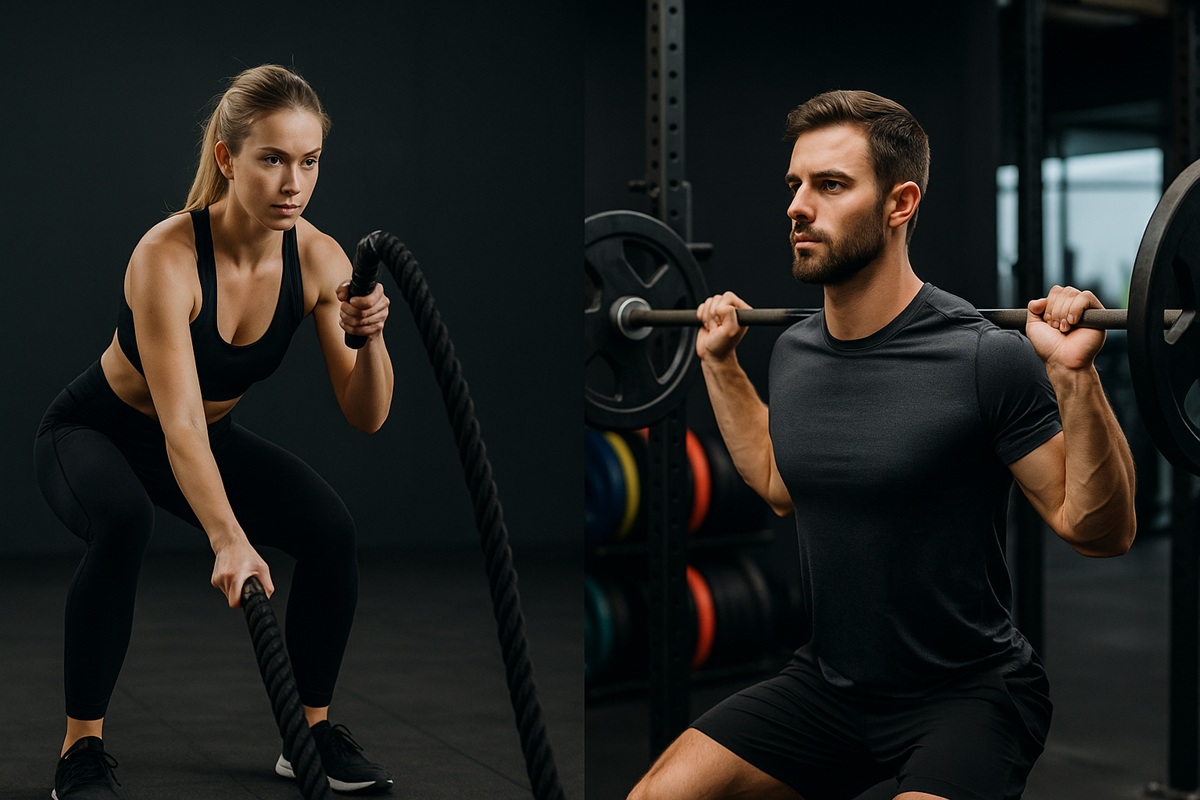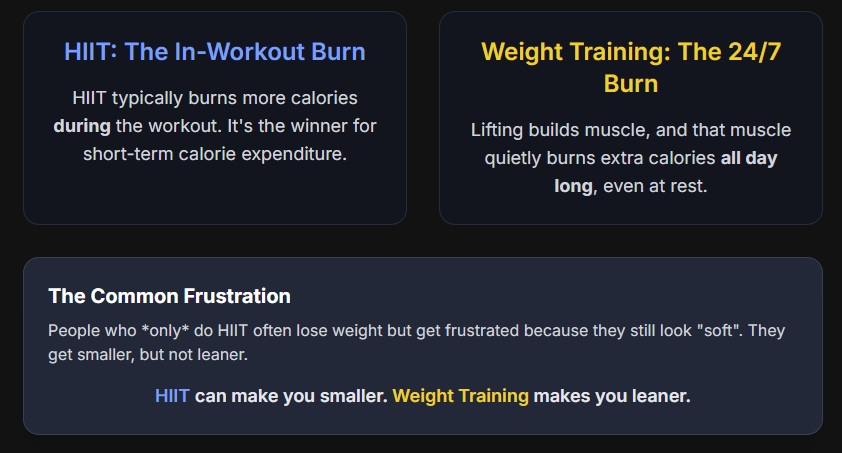HIIT vs Weight Training — Which One Burns More Fat and Builds a Better Body?

HIIT vs weight training is one of the most common debates in fitness. Some people swear that high-intensity intervals training (which stands for HIIT) melt fat faster than anything else. Others say lifting weights is the only real way to change how your body looks. So who’s right?
What HIIT Actually Is (and Why Everyone Talks About It)
HIIT stands for High-Intensity Interval Training. It’s short bursts of near-max effort followed by short recovery. Example: 30 seconds all-out sprint, 30 seconds rest, repeat 8–10 times.
HIIT is popular for three reasons:
- It burns a lot of calories fast.
- It keeps your heart rate high even after you stop (the “afterburn effect”).
- You don’t need a gym or equipment.
If you want a deeper breakdown of how HIIT works, common mistakes, and who should avoid it, check out What is HIIT Training.
What Weight Training Does (and Why It Matters for Fat Loss)
Weight training (also called strength training or resistance training) is any workout where you challenge your muscles against resistance: barbells, dumbbells, machines, cables, kettlebells, even bodyweight.
Here’s the part most people miss: strength training is not only for “muscle guys”. It’s one of the most powerful long-term fat loss tools you have, because:
- More muscle = higher resting calorie burn, even while you’re sitting and scrolling Shorts.
- You keep shape and firmness while you lose weight, instead of just getting “smaller but soft”.
- It supports healthy hormones and keeps you strong as you age.
To lift safely and actually progress, you should know your working weights. You can estimate them using your one-rep max. I explain how to calculate it before (even if you never test a true max) here: How to Calculate Your 1RM.
HIIT vs Strength Training: Which Burns More Fat?

Let’s answer the big question: Which is better for fat loss — HIIT or weight training?
The honest answer is: they work in different ways.
- HIIT burns a lot of calories during the workout. It spikes your heart rate, floods your body with effort, and can create a strong “afterburn” where you keep burning extra calories for hours.
- Strength training doesn’t always feel like “cardio”, but it changes your body’s baseline. You build muscle, and muscle quietly increases how many calories you burn 24/7 — not just during the workout.
So if you only look at the calories on your watch after one session, HIIT usually “wins”. But if you look at how your body looks in 3–6 months — tighter waist, better posture, stronger legs, visible shoulders — weight training usually wins.
This is why a lot of people get frustrated: they do nothing but HIIT and wonder why they’re “losing weight but still not happy with the mirror”. HIIT can make you smaller. Strength training can make you leaner.
If you’re curious how different types of cardio compare for fat loss, I also break down HIIT vs LISS (low-intensity steady state cardio like fast walking or easy cycling) here: HIIT vs LISS: Which Cardio Burns More Fat for Beginners.
Is HIIT Considered Strength Training?
Great question, and people Google this all the time: is HIIT cardio or strength?
Answer: it depends how you do it.
- If your HIIT is sprints, burpees, jump squats, mountain climbers — that’s mostly cardio. Heart rate focused. Conditioning focused.
- If your HIIT blocks include heavy kettlebell swings, dumbbell thrusters, push presses, weighted lunges — now you’re in a “hybrid zone”. You’re training your heart and your muscles at the same time. That’s sometimes called functional strength training.
But here’s the catch: HIIT is usually done with lighter or moderate weights and high speed. That’s not the same thing as progressive strength training with controlled reps, heavier loading, and planned progression using something like your 1RM. HIIT can challenge muscles, but it’s still not a replacement for structured lifting.
Should You Do HIIT and Strength Training in the Same Week?
Short answer: yes. That’s actually the best setup for most people who want fat loss plus muscle definition.
Here’s a simple example weekly structure:
- Day 1: Strength training (lower body focus: squats, lunges, Romanian deadlifts)
- Day 2: HIIT, 15–20 minutes (bike sprints, sled pushes, battle ropes)
- Day 3: Rest or light recovery (walking, mobility work, stretching)
- Day 4: Strength training (upper body: rows, presses, pulldowns, core)
- Day 5: HIIT, 10–15 minutes (bodyweight circuits or interval conditioning)
- Day 6: Optional full-body strength session or long easy cardio (LISS)
- Day 7: Rest
This split works for three reasons:
- You’re lifting often enough to build/keep muscle.
- You’re doing HIIT often enough to keep fat loss moving.
- You’re not killing yourself with daily “go hard or go home” workouts, which is exactly how people burn out.
Common Mistakes People Make
- Doing HIIT every day. HIIT is stress. Your nervous system, joints, and hormones also need recovery. More is not always better.
- Only doing cardio and avoiding weights “because I don’t want to get big”. You won’t “accidentally” become a bodybuilder. What actually happens if you skip strength training is: you lose weight, but also lose muscle, and you get weaker.
- Lifting with random weights and random reps. Track your progress. Know your numbers. Use your rep maxes. Again, here’s the calculator: How to Calculate Your 1RM.
So Which One Should You Choose?
If your only goal is “I need to burn calories fast because I have 20 minutes”, HIIT is great.
If your long-term goal is “I want a stronger, leaner body that actually keeps fat off”, strength training is non-negotiable.
The real answer to HIIT vs weight training is not “pick one”. It’s “use both with a purpose.”
Here’s a simple rule:
Lift to shape your body. Use HIIT to accelerate fat loss. Recover so you can repeat it next week.